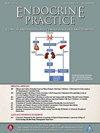Safety and Efficacy of the Novel RNA Interference Therapies for Hypertriglyceridemia and Mixed Hyperlipidemia Management: A Systematic Review and Meta-analysis
IF 3.7
3区 医学
Q2 ENDOCRINOLOGY & METABOLISM
引用次数: 0
Abstract
Background
No meta-analysis has holistically analyzed and summarized the safety and therapeutic efficacy of the newer RNA interference (RNAi) therapies, olezarsen, plozasiran, and zodasiran, in managing conditions associated with hypertriglyceridemia (HTG).
Methods
Randomized controlled trials (RCTs) involving patients with HTG or mixed hyperlipidemia (MHL) receiving either olezarsen, plozasiran, or zodasiran in the intervention arm and a placebo in the control arm were searched through electronic databases. The primary outcome was the safety profile of the drugs studied; secondary outcomes included the percent change from baseline (CFB) in the lipid levels, including triglyceride (TG).
Results
Six RCTs with 334 participants were evaluated. Olezarsen, plozasiran, and zodasiran were well-tolerated with no higher risk of serious adverse events or injection-site reactions. After 24 weeks, plozasiran increased alanine aminotransferase and HbA1c more than placebo, although the difference was insignificant at 48 weeks. Plozasiran and zodasiran had little effect on hyperglycemia worsening. Olezarsen increased the likelihood of mild platelet count decreases without clinical harm. At their longest clinical trial follow-up, the highest doses of olezarsen, plozasiran, and zodasiran lowered TG by 55.2%, 50.57%, and 51.2% of baseline levels. All three drugs decreased non-HDL-C and remnant cholesterol. Olezarsen and plozasiran lowered ApoC-III and increased HDL-C, whereas zodasiran reduced HDL-C. Zodasiran decreased LDL-C, whereas olezarsen and plozasiran had no effects on LDL-C. Plozasiran and zodasiran lowered apolipoprotein B, but not olezarsen.
Conclusion
The newer RNA interference (RNAi) therapies appear safe and have excellent TG-lowering efficacy in patients with HTG and MHL.
新型 RNA 干扰疗法治疗高甘油三酯血症和混合型高脂血症的安全性和有效性:系统综述和荟萃分析。
背景目前还没有荟萃分析全面分析和总结较新的RNA干扰(RNAi)疗法--奥利沙砷、plozasiran和zodasiran--在治疗高甘油三酯血症(HTG)相关疾病方面的安全性和疗效:通过电子数据库检索了涉及高甘油三酯血症(HTG)或混合型高脂血症(MHL)患者的随机对照试验(RCT),这些患者在干预组接受奥利沙砷、普洛沙西兰或佐达西兰治疗,在对照组接受安慰剂治疗。主要结果是研究药物的安全性;次要结果包括血脂水平(包括甘油三酯)与基线相比的变化百分比(CFB):结果:共评估了六项 RCT 研究,共有 334 人参与。奥利沙砷、plozasiran 和佐达西兰的耐受性良好,没有出现严重不良事件或注射部位反应的更高风险。24 周后,plozasiran 比安慰剂更容易增加丙氨酸氨基转移酶和 HbA1c,但在 48 周时差异并不显著。普洛扎西兰和佐达西兰对高血糖恶化的影响很小。奥利沙砷会增加血小板计数轻度下降的可能性,但不会造成临床损害。在最长的临床试验随访中,最高剂量的奥利沙砷、普洛沙西兰和佐达西兰分别将总胆固醇降低了基线水平的55.2%、50.57%和51.2%。这三种药物都能降低非高密度脂蛋白胆固醇和残余胆固醇。Olezarsen和plozasiran降低了载脂蛋白C-III,增加了高密度脂蛋白胆固醇,而佐达西兰则降低了高密度脂蛋白胆固醇。佐达西兰降低了低密度脂蛋白胆固醇,而奥利沙砷和plozasiran对低密度脂蛋白胆固醇没有影响。Plozasiran和Zodasiran能降低脂蛋白B,而奥利沙砷不能:结论:较新的 RNA 干扰(RNAi)疗法似乎是安全的,而且对 HTG 和 MHL 患者有很好的降低总胆固醇的疗效。
本文章由计算机程序翻译,如有差异,请以英文原文为准。
求助全文
约1分钟内获得全文
求助全文
来源期刊

Endocrine Practice
ENDOCRINOLOGY & METABOLISM-
CiteScore
7.60
自引率
2.40%
发文量
546
审稿时长
41 days
期刊介绍:
Endocrine Practice (ISSN: 1530-891X), a peer-reviewed journal published twelve times a year, is the official journal of the American Association of Clinical Endocrinologists (AACE). The primary mission of Endocrine Practice is to enhance the health care of patients with endocrine diseases through continuing education of practicing endocrinologists.
 求助内容:
求助内容: 应助结果提醒方式:
应助结果提醒方式:


